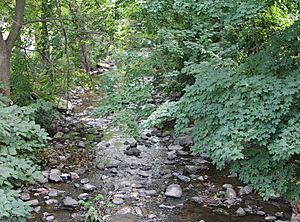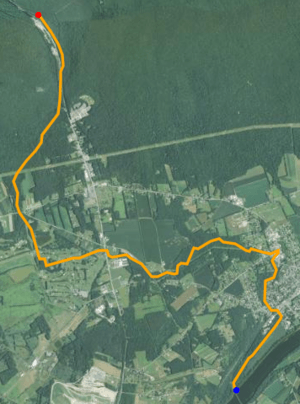Black Hole Creek facts for kids
Black Hole Creek is a small stream in Lycoming County, Pennsylvania. It flows into the West Branch Susquehanna River near a town called Montgomery. The creek is about 8 miles (13 kilometers) long. It's known for having trout fish. The water temperature in the creek can change a lot, especially after it passes a pond near the Allenwood Federal Prison.
Contents
Where Does Black Hole Creek Flow?
Black Hole Creek begins its journey near U.S. Route 15. The first part of the creek flows through thick forests. As it continues, the middle section of the creek winds through a golf course. Finally, the last part of the creek flows through areas with residential homes and farmland.
The creek has three main smaller streams that flow into it. It also has many other tiny streams that only flow sometimes, especially after rain. One of these smaller streams is called Spring Creek.
Long ago, in 1888, a magazine article said that Black Hole Creek started from a place known as the Black Hole.
How Water Affects the Creek
Many things affect the water in Black Hole Creek. There are 18 bridges that cross over the creek. Also, 20 pipes either flow into the creek or run underneath it.
The creek has two small dams made of rocks. There's also a larger earthen dam near the Allenwood Federal Prison. This dam can make the water in the creek warmer. A blocked culvert (a tunnel for water) on the prison grounds also adds to the water getting warmer.
In the 1980s or 1990s, the White Deer Golf Course was made bigger. During this work, some culverts were built, which created a pond with brownish water. This pond then flows into Black Hole Creek. Another pond near the Allenwood Federal Prison also flows into the creek, making its water much warmer.
Scientists have measured the water temperature in Black Hole Creek at different spots. In July 2005, the water at the very beginning of the creek was about 66.6°F (19.2°C). But where the prison pond water entered, it was much warmer, around 80.6°F (27°C). Further downstream, the temperature cooled down a bit to 71.6°F (22°C).
They measured again in April 2010. The water at the start was 52.5°F (11.4°C). At the prison pond area, it was 65.2°F (18.4°C). Downstream, it was 59.2°F (15.1°C). These measurements show how the prison pond can change the creek's temperature.
History of Black Hole Creek
A very old path called the Sheshequin Path once passed close to Spring Creek, which is a smaller stream flowing into Black Hole Creek. In 1889, Black Hole Creek had a big, sudden flood. This flood caused a lot of damage to the town of Montgomery. The creek was even shown on maps of the area as early as 1779.
For many years, Black Hole Creek was used by the people of Montgomery for their sewers. Even in 1913, several sewers emptied into the creek. For example, the Board Street Sewer was about 2,400 feet (730 meters) long and had pipes between 8 and 15 inches (20 to 38 cm) wide. Other sewers also ran under streets and from houses into the creek.
Until 1905, Black Hole Creek was the main source of water supply for the town of Montgomery.
What's in a Name?
Black Hole Creek was not always called by its current name. It was originally known as Black Haw Creek.
Animals and Plants in the Creek
Black Hole Creek is a good home for trout fish, and many are found there. At the beginning of the creek, there's a special area along the banks called a riparian buffer. This area has plants that help protect the creek.
Some plants in this buffer include speckled alder, which were planted by a group called the Black Hole Creek Watershed Association. You can also find Lobelia cardinalis growing naturally there.



